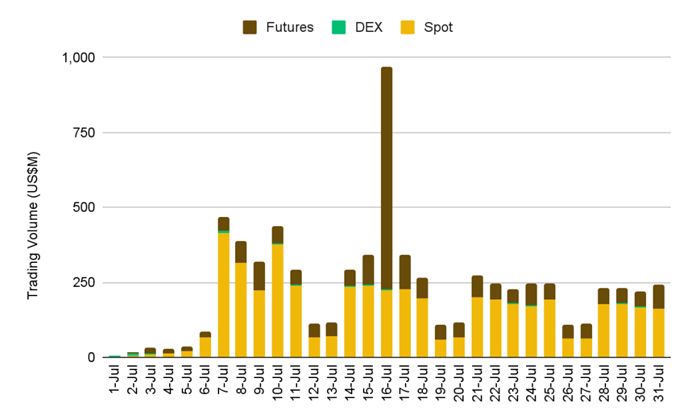Animoca Brands has launched NUVA, a marketplace for tokenized real-world assets, aimed at addressing the fragmented tokenization landscape and enhancing accessibility for investors.
-
NUVA offers institutional-grade tokenized assets, including yield-bearing stablecoin securities and home equity lines of credit.
-
Developed with Provenance Blockchain, the platform aims to unify the fragmented tokenization marketplace.
-
Assets on NUVA are designed to bring liquidity to traditionally illiquid real-world assets.
Animoca Brands has launched NUVA, a new marketplace for tokenized real-world assets, enhancing accessibility for investors in a fragmented landscape.
| Tokenized Product | Type | Value |
|---|---|---|
| YLDS | Yield-bearing stablecoin security | Approved in the US |
| HELOC | Home equity lines of credit | Pool of fixed-rate loans |
What is NUVA and How Does It Work?
NUVA is a new marketplace launched by Animoca Brands, designed to facilitate access to tokenized real-world assets (RWAs). It leverages Provenance Blockchain to unify the fragmented tokenization landscape, offering institutional-grade products like yield-bearing stablecoin securities and home equity lines of credit.
Why is Tokenization Important for Investors?
Tokenization is crucial as it enhances liquidity for traditionally illiquid assets, allowing investors to trade and transfer them across decentralized finance exchanges. The vault structure used in NUVA simplifies access to these tokenized products, making them more accessible to a broader range of investors.
Frequently Asked Questions
What types of assets are available on NUVA?
NUVA offers a range of tokenized products, including yield-bearing stablecoin securities and home equity lines of credit, enhancing investor access to diverse financial instruments.
How does NUVA improve accessibility for investors?
By utilizing a vault-based structure, NUVA allows investors to easily access tokenized assets, particularly benefiting those who traditionally lack access to conventional financial platforms.
Key Takeaways
- NUVA enhances accessibility: The platform aims to unify the fragmented tokenization landscape.
- Institutional-grade assets: Offers products like yield-bearing stablecoin securities and home equity lines of credit.
- Liquidity for RWAs: NUVA brings liquidity to traditionally illiquid assets, benefiting a wider range of investors.
Conclusion
In summary, NUVA represents a significant advancement in the tokenization of real-world assets, addressing the challenges of accessibility and liquidity. As the market for tokenized assets continues to grow, platforms like NUVA will play a crucial role in shaping the future of finance.
Built with Provenance Blockchain, NUVA offers institutional-grade tokenized assets like stablecoin securities and HELOCs.
Web3 company Animoca Brands has launched a new marketplace for investors to access tokenized real-world assets (RWAs), fixing what its CEO calls a “fragmented” tokenization marketplace at a time of growing institutional interest in the technology.
The new platform, called NUVA, was developed in partnership with ProvLabs, the organization behind the Provenance Blockchain, according to a joint announcement on Thursday.
The NUVA marketplace will leverage Provenance Blockchain’s existing ecosystem of RWAs, which currently holds assets valued at approximately $15.7 billion.
At launch, NUVA will offer exposure to two tokenized products from Figure Technologies: YLDS, the first yield-bearing stablecoin security approved in the US, and HELOC, a pool of fixed-rate home equity lines of credit.
These assets will be offered through “vaults,” a structure that enables easier and more efficient investor access to tokenized products.
Vault-based marketplaces are increasingly recognized for expanding accessibility, particularly for investors who are traditionally underserved or lack access to conventional financial platforms.
“The vault tokens are liquid claims to the yielding real-world assets stored in each vault,” ProvLabs CEO Anthony Moro told Cointelegraph in a written statement, adding:
“For example, when investors hold nuYLDS, they receive tokenized exposure to YLDS, the SEC-registered yielding stablecoin, and when they hold nuHELOCs, they get tokenized exposure to a pool of high quality of home equity loans issued by Figure Technologies, the largest non-bank issuers of HELOCs in the US.”
These so-called nuAssets bring liquidity to traditionally illiquid RWAs, giving investors the option to trade and transfer them across chains and decentralized finance exchanges.

Total RWA market size, excluding stablecoins. Source: RWA.xyz
Animoca Brands’ co-founder and executive chairman, Yat Siu, said NUVA is intended to tap into a growing RWA market that remains “fragmented across chains and marketplaces, [which] limits their reach and impact.”
NUVA intends to fix this gap by making “institutional-quality assets radically more accessible across a unified, multichain ecosystem,” said Siu.
Related: VC Roundup: Investors continue to back DePIN, Web3 gaming, layer-1 RWAs
Tokenization boom expected to accelerate with supportive regulations
Tokenized finance is emerging as one of the most influential trends shaping the crypto industry in 2025, with the rise of RWA tokenization driven by growing demand for products like private credit and US Treasury bonds.
As Cointelegraph reported, the tokenized RWA market — excluding stablecoins — has surged by as much as 380% since 2022.
Tokenized stocks are also gaining momentum, reaching a total market capitalization of $370 million by the end of July, representing a 220% increase in just one month, according to Binance Research.

Blockchain addresses holding tokenized stocks in July. Source: Binance Research
Industry experts told Cointelegraph that recent regulatory developments in the US, particularly those surrounding stablecoins, could create a more favorable environment for the continued expansion of RWA tokenization in the years ahead.
Major institutions are also taking notice. JPMorgan recently highlighted the role of tokenized money market funds as a way to preserve the appeal of cash in digital ecosystems.
“Instead of posting cash, or posting Treasurys, you can post money-market shares and not lose interest along the way,” said JPMorgan strategist Tereso Ho said, referring to the operational benefits of tokenized money market funds.
Paul Brody, EY’s global blockchain leader, added that tokenized deposits and tokenized money market funds “could find a significant new opportunity onchain,” signaling strong institutional confidence in the sector’s future.
Related: Tokenized money market funds emerge as Wall Street’s answer to stablecoins




